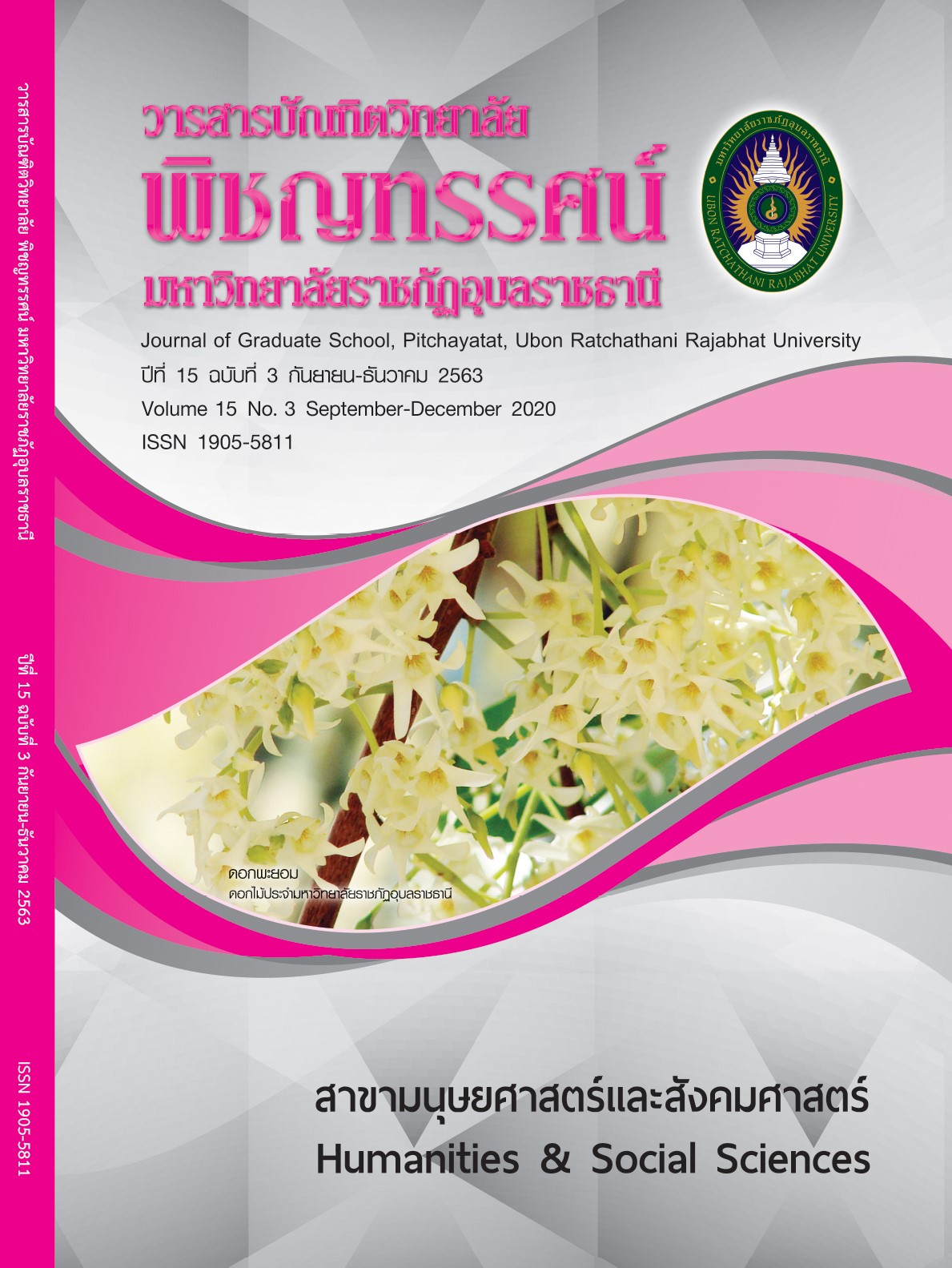Forms and Concepts Used in the Creation of a Dance: She Tells through the Creative Process Based on the Post-Modern Dance Concept
Keywords:
the Creation of the Dance, Processes, the Post-Modern DanceAbstract
The objectives of this research were: 1) to find forms used in the creation of a dance: she tells… based on the post-modern dance concept and 2) to find the concept received after the creation of the dance: she tells…. The data were collected in the form of the qualitative research and by studying the documents, interviewing the research participants, searching information from media and information technology, observing, arranging seminars, and using self-experience. Then, they were analyzed and synthesized to create the dance performance that was selected to show at the international shows for three times.
The research findings were found as follows.
The forms of the creation of the dance consisted of 7 components: designing role-playing, selecting actors/actresses, designing choreographies, designing costumes, designing sounds, designing performance stages, and designing lights. After creating the dance, 5 concepts of the creation were found. The 5 concepts consisted of the female rights and freedom, the post-modern dance, semiology concepts, art concepts and theories, and the creation of the shows that were arts for arts. The evaluation was conducted by sending the dance to the international dance festivals, so the dance was selected to show in the festivals. Showing the dance in the international dance festivals was the public relation in the form of the post-modern dance in Thailand, and this shows distributed the knowledge that was beneficial to someone interested in studying the creation of the post-modern dance in the future.
References
กุลพล พลวัน. สิทธิมนุษยชนในสังคมไทย. บริษัท กานดาพร็อพเพอร์ตี้ จำกัด และบริษัทในเครือ: กรุงเทพฯ, 2543
ดาริณี ชำนาญหมอ. การสร้างสรรค์นาฏยศิลป์เพื่อผู้หญิงกับการยุติความรุนแรง. วิทยานิพนธ์หลักสูตรปริญญาศิลปกรรมศาสตรดุษฎีบัณฑิต จุฬาลงกรณ์มหาวิทยาลัย, 2557.
นราพงษ์ จรัสศรี. ประวัตินาฏยศิลป์ตะวันตก. กรุงเทพฯ: สำนักพิมพ์แห่งจุฬาลงกรณ์มหาวิทยาลัย, 2548.
นราพงษ์ จรัสศรี. นาฏยศิลป์สร้างสรรค์ (สัมภาษณ์). ศาสตราจารย์ ประจำภาควิชานาฏยศิลป์ คณะศิลปกรรมศาสตร์ จุฬาลงกรณ์มหาวิทยาลัย, 7 กุมภาพันธ์ 2560
ทิชา ณ นครและคณะ. ผู้หญิงกับรัฐธรรมนูญ: บันทึกการเดินทางสู่ความเสมอภาค. กรุงเทพฯ: บริษัท พี.เพรส จำกัด, 2545.
พรสวรรค์ สุวรรณธาดา. “แม่พลอยกับเฟมินิสม์,” มนุษยศาสตร์ สังคมศาสตร์. 28, 3 (กันยายน-ธันวาคม 2554): 51-72.
ราชบัณฑิตยสถาน. พจนานุกรมฉบับราชบัณฑิตยสถาน พ.ศ. 2542. กรุงเทพฯ: นานมีบุ๊คส์พับลิเคชั่นส์, 2546.
วิรุณ ตั้งเจริญ. “ลัทธิหลังสมัยใหม่ ศิลปะหลังสมัยใหม่,” วารสารราชบัณฑิตยสถาน. 27, 2 (เมษายน-มิถุนายน 2545): 330-341.
สิริธร ศรีชลาคม. การสร้างสรรค์นาฏยศิลป์ร่วมสมัยร่วมกับการฉายภาพสำหรับการแสดง: มาย แท็งก์ (My Tank). วิทยานิพนธ์หลักสูตรปริญญาศิลปกรรมศาสตรดุษฎีบัณฑิต จุฬาลงกรณ์มหาวิทยาลัย, 2559.
สุภางค์ จันทวานิช. การวิเคราะห์ข้อมูลในการวิจัยเชิงคุณภาพ. พิมพ์ครั้งที่ 11. กรุงเทพฯ: สำนักพิมพ์แห่งจุฬาลงกรณ์มหาวิทยาลัย, 2556.
อรพิมล ทองทิพย์. รูปแบบการสร้างสรรค์นาฏยศิลป์ (สัมภาษณ์). นักศึกษาสาขาวิชานาฏยศิลป์ วิชาเอกนาฏยศิลป์สากล คณะมนุษยศาสตร์และสังคมศาสตร์ มหาวิทยาลัยราชภัฏบ้านสมเด็จเจ้าพระยา, 30 เมษายน 2562.
Downloads
Published
How to Cite
Issue
Section
License
Every article is peer-reviewed for academic correctness by at least two external qualified experts. The opinions in the Journal of Graduate School, Pitchayatat, Ubon Ratchathani Rajabhat University (Humanities and Social Sciences) belong to the authors; not belong to the Publisher. Thus, Graduate School of Ubon Ratchathani Rajabhat University cannot to be held responsible for them. The articles in this journal are protected by the copyright of Thailand. No part of each issue may be reproduced for dissemination without written permission from the publisher.





